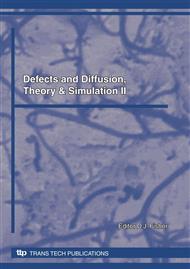[1]
Saito, F., Yotoriyama, T., Fujii, Y., Nagashima, Y., Nakao, A., Iwaki, M., Nishiyama, I., Hyodo, T., Study of ion-irradiated polystyrene using slow positron beam. Radiation Physics and Chemistry, 76 (2007) 200-3.
DOI: 10.1016/j.radphyschem.2006.03.035
Google Scholar
[2]
Tashiro, M., Honda, Y., Terashima, Y., Watanabe, M., Pujari, P.K., Tagawa, S., Study of interfaces in polymer bilayers using slow positron beam. Applied Surface Science, 194 (2002) 182–8.
DOI: 10.1016/s0169-4332(02)00121-6
Google Scholar
[3]
Jean, Y.C., Chen, Hongmin., Zhang, R., Li, Ying., Zhang, Junjie., Early stage of deterioration in polymeric coatings detected by positron annihilation spectroscopy. Progress in Organic Coatings, 52 (2005) 1-8.
DOI: 10.1016/j.porgcoat.2003.09.022
Google Scholar
[4]
Brandt, W., Berko, S., Walker, W.W., Positronium decay in molecular substances, Physical Review, 120 (1960) 1289.
DOI: 10.1103/physrev.120.1289
Google Scholar
[5]
McGervey, D., Walters, V.F., Correlation between lifetime momentum for positron annihilation in Teflon, Physical Review B, 2 (1970) 2421.
DOI: 10.1103/physrevb.2.2421
Google Scholar
[6]
Shultz, P.J., Lynn, K.G., Interaction of positron beams with surfaces, thin films and interfaces, Reviews of Modern Physics, 60 (1988) 701.
DOI: 10.1103/revmodphys.60.701
Google Scholar
[7]
Shrivastava, S.B., Rathore, M.K., Rathore, V., Joshi, K.P., Gupta V.K., Positron annihilation at polymeric surfaces, Surface Review and Letters, 11 (2004) 1-8.
DOI: 10.1142/s0218625x04005822
Google Scholar
[8]
Consolati, G., Kansy, J., Pagoraro, M., Quasso, F., Zanderighi L., Positron annihilation study of free volume in cross-linked amorphous polyurethanes through the glass transition temperature, Polymer, 39s (1998) 3491.
DOI: 10.1016/s0032-3861(97)10063-5
Google Scholar
[9]
Forrest J.A., Dalnoki Veress , K., Stevens, J.R., Duther, J.R., Effect of free surfaces on the glass transition temperature of thin polymer films, Physical Review Letters, 77 (1996) (2002).
DOI: 10.1103/physrevlett.77.2002
Google Scholar
[10]
Aklonis, J.J., Macknight in W.J., Introduction to Polymer Viscoelasticity, 2nd Edition, John Wiley & Sons, NY (1983) p.15.
Google Scholar
[11]
Cao, H., Zhang, R., Yuan, J.P., Huang, C.M., Jean Y.C., Suzuki, R., Odhria, T., Nielson, B., Free volume hole model for positronium formation in polymers: surface studies, Journal of Physics - Condensed Matter, 10 (1998) 10429.
DOI: 10.1088/0953-8984/10/46/011
Google Scholar
[12]
Suzuki, C. He. T., Hamada, E., Kobayashi, Kondo, K., Santarovich, V.P., Ito Y., Materials Research Innovations, 7 (2003) 37.
Google Scholar
[13]
Bartos J., Free volume microstructure of amorphous polymers of glass transition temperatures from positron annihilation spectroscopy data, Colloid and Polymer Science, 274 (1996) 14.
DOI: 10.1007/bf00658904
Google Scholar


